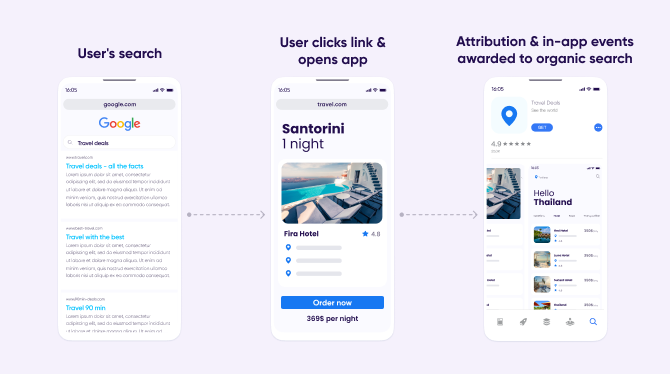Navigating an economic downturn: 3 ways to utilize SEO to boost your app marketing growth


Have you ever tried to hold onto sand as it pours through your fingers?
It’s difficult to grab onto more than a few grains. Without the right tools, it will all spill over.
Not so critical when discussing sand. But what about your SEO (search engine optimization) efforts?
In the current economic climate, businesses of all sizes are doubling down and rethinking their efforts and investments, across all marketing initiatives. But how can you determine what’s helping you reach your business goals without appropriate measurement?
While this is true for all marketing, it’s particularly important (yet often overlooked) when it comes to SEO.
Often, SEO is considered a black box, or simply labeled as “organic”, “unattributed”, or “unknown” traffic. But, just as no one wants to get covered in sand, no one wants to be investing time and effort in specific SEO channels and endeavors, without being able to truly evaluate their worth.
In this post we’ll look at how best to use your SEO efforts to boost your app growth, during an economic downturn and beyond.
The status quo: driving at night with your headlights off
Currently, measuring the impact of SEO has many blindspots. And, much like driving with your headlights off, if you can’t understand the impact of your SEO efforts you may get stuck in the mud (or worse).
Today, many brands are forced to choose between two imperfect scenarios: sending users directly to their app through deep linking, or sending them to a mobile website.

If you choose the former and opt to send users directly to your app via deep linking, the ability to attribute in-app events to the original SEO efforts that brought users will be lost. So, if a particular search engine is bringing higher quality users, you won’t have the data to back-up investing further in SEO. This is particularly impactful given that, according to AppsFlyer research, an average of 15-20% of app opens originate from organic search.
On the other hand, if you’re looking to drive organic app installs but are opting to direct your users to a mobile website instead of your app, you’re going to be delivering an inferior and clunky user experience that may lead to losing users altogether. In our current economic climate, the need to hone in on the sources that are truly driving app launches and in-app events becomes even more critical. According to a recent Gartner survey, “71% of CMOs believe that they lack sufficient budget to fully execute their marketing strategy.” Maximizing the value of your existing channels and driving consistent marketing efforts is key to thriving in this climate.
How can you get more from your SEO efforts? We suggest these three tips:
1) Measure the full impact of your SEO efforts
Did you know that 24% of eCommerce orders are directly linked to organic traffic?
Given the value that organic search can offer, it’s critical to ensure you’re measuring the impact of your SEO efforts and attributing in-app and down-the-funnel events back to those original searches.
Check that your MMP offers robust measurement of both global and regionally popular search engines. So, as well as Google, Bing, DuckDuckGo, Ask, and Yahoo, think about Yandex, Naver, Daum, Baidu, and other locally specific ones to attract your target audience.
2) Utilize SEO to thrive in a post iOS 14.5 reality
Once you’ve identified the search engines that are bringing you the best traffic, compensate for remarketing difficulties (and expenses) by doubling–down on those efforts to draw your users back.
According to recent studies, nearly 1 in every 2 apps are uninstalled within 30 days of the initial download. Given the decline in app retention and in the face of increasingly fierce competition, remarketing is becoming ever-more critical.
In a post-iOS 14.5 reality, remarketing is becoming increasingly challenging. As we move into the next phase of privacy-related enhancements, SEO is a consistent, privacy-forward avenue to re-engage with your users, without relying on signals and device IDs.
3) Leverage SEO for zero-budget user acquisition
Let’s revisit one of our original issues with SEO: the user journey for those that haven’t downloaded your app.
Say, for example you have a travel app. Today, a user that does not have your app may find you via search while looking for ‘hotels in New York with insanely delicious cronuts’. They’re interested (who wouldn’t be?) and they click the link to be redirected to your mobile website and then off to the app store. In this current journey, you will see a user that came from a landing page, but the entire upper-end of the funnel (cronuts and all) will be lost!

To gain complete visibility to your user’s journey, consider leveraging smart scripts in landing pages and mapping the user’s web referrer.
By leveraging smart scripts, you’ll be able to locate the organic efforts that drove a user to your website and then app, and gain exposure to the complete journey.
Measuring everything and continuing to grow
SEO has always been considered a long-term strategy, one that builds trust and loyalty with your user base over the years. And while that remains to be true, there may be more concrete, monetary benefits to investing in SEO today, beyond the branding approach.







